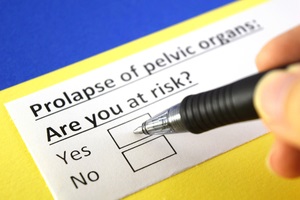 Your body will change in many ways throughout your lifetime, but some of these changes can be uncomfortable and disruptive. One problem that can affect women is pelvic organ prolapse, particularly in the uterus.
Your body will change in many ways throughout your lifetime, but some of these changes can be uncomfortable and disruptive. One problem that can affect women is pelvic organ prolapse, particularly in the uterus.
Pelvic Organ Prolapse
When the muscles and ligaments in the pelvic floor stretch and weaken to the point where they can no longer provide sufficient support for the uterus, the uterus may slip down into the vagina or protrude out of it. Although this can occur to women of all ages, it most often impacts post-menopausal women who have given birth vaginally in the past.
Uterine prolapse is typically associated with the prolapse of other pelvic organs. It can present in one of two ways: anterior prolapse or posterior vaginal prolapse.
Anterior Prolapse
Anterior prolapse, also known as prolapsed bladder or cystocele, occurs when the weakness of the connective tissue that separates the bladder from the vagina causes the bladder to bulge out into the vagina.
Posterior Vaginal Prolapse
Also known as rectocele, posterior vaginal prolapse occurs when the connective tissue that separates the rectum from the vagina becomes so weak that it allows the rectum to bulge out into the vagina. This may cause difficulty with bowel movements.
In some cases, severe uterine prolapse displaces part of the vaginal lining in a way that makes it protrude outside of the body. When vaginal tissue rubs against clothing, it can result in vaginal sores or ulcers that may become infected.
Symptoms
Uterine prolapse is often mild and does not typically have signs or symptoms. However, when the prolapse is moderate to severe, you may notice:
- A sensation of looseness in vaginal tissue tone
- Tissue protruding from the vagina
- Trouble with bowel movements
- Urinary leakage, urine retention or other urinary problems
- A sensation of pulling or heaviness in the pelvis
- The feeling of sitting on a small ball
- A sensation that something is falling out of the vagina
These symptoms are often less noticeable in the morning and get worse as the day goes on.
What Are the Causes Of Pelvic Organ Prolapse?
Pelvic organ prolapse occurs when pelvic muscles and supportive tissues become weakened. This can be caused by:
- Lower estrogen levels following menopause
- Chronic bronchitis or cough
- Delivering a large baby
- A difficult labor and delivery
- Trauma during childbirth
- Pregnancy
- Chronic constipation
- Repeated straining during bowel movements
- Repeated heavy lifting
 Although this condition can affect any woman, you are more susceptible to experiencing pelvic organ prolapse if you have ever been pregnant. A history of vaginal births or giving birth to a large baby can also raise your risk. Women with a family history of weakness in their connective tissue or who have had pelvic surgery in the past are also more vulnerable to prolapse.
Although this condition can affect any woman, you are more susceptible to experiencing pelvic organ prolapse if you have ever been pregnant. A history of vaginal births or giving birth to a large baby can also raise your risk. Women with a family history of weakness in their connective tissue or who have had pelvic surgery in the past are also more vulnerable to prolapse.
Your risk of experiencing prolapse increases with age and weight, and Hispanic and white women also have a higher risk. Frequent straining during bowel movements and constipation can also increase your risk of pelvic organ prolapse.
How Can You Prevent Uterine Prolapse?
If you have a higher risk of uterine prolapse, there are some steps you can take to reduce the chances of developing this condition. Here are some of the best ways to reduce your risk.
Perform Kegel Exercises
Kegel exercises can help to strengthen the muscles in your pelvic floor, which is particularly important after you have given birth. These exercises are easy to perform, and you can find instructions online.
Avoid Heavy Lifting
You should avoid lifting heavy objects if you are concerned about prolapse. When you do need to lift something, it is imperative to focus on using your legs rather than your back or waist. If you lift weights, make sure that you are doing so correctly.
Avoid Excess Weight
Maintaining a healthy weight is a great way to reduce your risk of uterine prolapse and maintain optimum overall health. Your doctor can help you determine your ideal weight and provide you with any strategies that are needed to reach that number.
Address Coughing
If you experience chronic coughing or bronchitis, it is important to get treatment. You should also avoid smoking.
Avoid Constipation
Because constipation is strongly connected to prolapse, it is important to take steps to treat and prevent constipation. Ensure you drink plenty of fluids and consume a variety of high-fiber foods, including vegetables, beans, whole grains, and fruits.
How Is Pelvic Organ Prolapse Diagnosed And Treated?
A gynecologist can diagnose uterine prolapse with a pelvic exam. During the exam, you may be asked to bear down as though you are having a bowel movement so the doctor can assess just how far the uterus is slipping into the vagina. You may also be asked to tighten your pelvic muscles as though you are trying to stop a stream of urine so the doctor can determine the strength of your pelvic muscles.
Mild pelvic organ prolapse does not usually require treatment. Many times, performing Kegel exercises, treating constipation, and losing weight can provide relief. A pessary, a plastic or rubber ring that is inserted into the vagina to support bulging tissues, may also be an option.
When the symptoms of prolapse disrupt normal activities, surgery may be recommended. Vaginal surgery or minimally invasive laparoscopic surgery can be used to repair weakened pelvic floor tissues.
Get In Touch With Raleigh Gynecology & Wellness
If you are experiencing symptoms of pelvic organ prolapse, reach out to the women’s healthcare team at Raleigh Gynecology & Wellness. Their team can diagnose the condition and help you find the right treatment.
